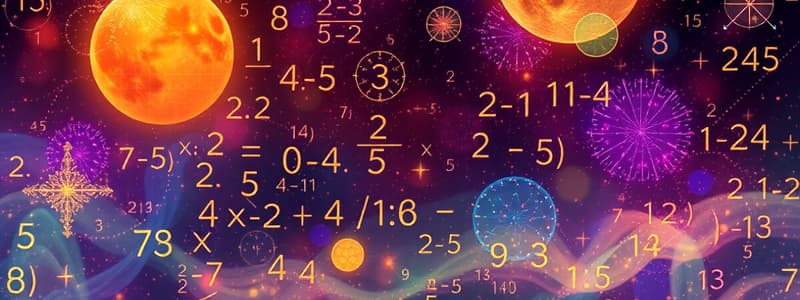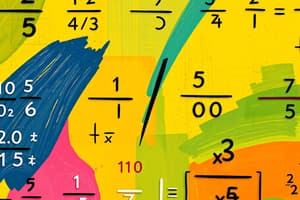Podcast
Questions and Answers
What is the main operation performed in multiplication?
What is the main operation performed in multiplication?
- Finding the difference between two numbers
- Splitting a number into equal parts
- Combining two or more numbers
- Repeated addition of a number (correct)
Which of the following correctly represents a fraction?
Which of the following correctly represents a fraction?
- A multiple of a number
- The difference between two numbers
- Only the decimal form of a number
- A part of a whole, shown as a numerator over a denominator (correct)
What does the decimal 0.75 represent in fraction form?
What does the decimal 0.75 represent in fraction form?
- 5/3
- 7/5
- 1/2
- 3/4 (correct)
What do percentages primarily express?
What do percentages primarily express?
What does the symbol '√' represent?
What does the symbol '√' represent?
Which of the following best describes an algebraic expression?
Which of the following best describes an algebraic expression?
What is the fundamental unit of measurement for volume?
What is the fundamental unit of measurement for volume?
How can data analysis be visually represented?
How can data analysis be visually represented?
What is the purpose of simplifying fractions?
What is the purpose of simplifying fractions?
Which of the following is a basic shape studied in geometry?
Which of the following is a basic shape studied in geometry?
What is the primary purpose of using statistical measures like mean, median, and mode?
What is the primary purpose of using statistical measures like mean, median, and mode?
Which of the following is not a type of number system?
Which of the following is not a type of number system?
What defines a proportion in mathematics?
What defines a proportion in mathematics?
In the order of operations, which operation is performed last?
In the order of operations, which operation is performed last?
What is a key technique often employed in problem-solving?
What is a key technique often employed in problem-solving?
Which of the following statements about sets is true?
Which of the following statements about sets is true?
What is a characteristic of irrational numbers?
What is a characteristic of irrational numbers?
Which order does the 'E' in PEMDAS represent?
Which order does the 'E' in PEMDAS represent?
What mathematical operation is primarily indicated by a ratio?
What mathematical operation is primarily indicated by a ratio?
Which set of numbers includes both rational and irrational numbers?
Which set of numbers includes both rational and irrational numbers?
Flashcards
Addition
Addition
Combining two or more numbers to find their sum. Represented by the '+' symbol.
Subtraction
Subtraction
Finding the difference between two numbers. Represented by the '-' symbol.
Multiplication
Multiplication
Repeated addition of a number. Represented by '×' or '*'.
Division
Division
Signup and view all the flashcards
Fractions
Fractions
Signup and view all the flashcards
Decimals
Decimals
Signup and view all the flashcards
Percentages
Percentages
Signup and view all the flashcards
Exponents
Exponents
Signup and view all the flashcards
Geometry
Geometry
Signup and view all the flashcards
Measurement
Measurement
Signup and view all the flashcards
Mean
Mean
Signup and view all the flashcards
Median
Median
Signup and view all the flashcards
Mode
Mode
Signup and view all the flashcards
Number system
Number system
Signup and view all the flashcards
Rational numbers
Rational numbers
Signup and view all the flashcards
Irrational numbers
Irrational numbers
Signup and view all the flashcards
Ratio
Ratio
Signup and view all the flashcards
Proportion
Proportion
Signup and view all the flashcards
Order of operations (PEMDAS/BODMAS)
Order of operations (PEMDAS/BODMAS)
Signup and view all the flashcards
Problem solving
Problem solving
Signup and view all the flashcards
Study Notes
Basic Arithmetic Operations
- Addition involves combining two or more numbers to find their sum. The '+' symbol represents addition.
- Subtraction involves finding the difference between two numbers. The '-' symbol represents subtraction.
- Multiplication involves repeated addition of a number. The '×' or '*' symbol represents multiplication.
- Division involves splitting a number into equal parts. The '÷' or '/' symbol represents division.
Fractions
- Fractions represent parts of a whole. A fraction consists of a numerator (top number) and a denominator (bottom number).
- A fraction represents the division of the numerator by the denominator.
- Fractions can be simplified to their lowest terms by dividing both the numerator and denominator by their greatest common divisor (GCD).
- Mixed numbers combine a whole number and a fraction.
Decimals
- Decimals represent fractional values using a decimal point.
- Operations like addition, subtraction, multiplication, and division can be performed on decimals.
- Decimals can be converted to fractions and vice versa.
Percentages
- Percentages represent a fraction or ratio as a part of 100.
- Percentages are often used to express proportions or rates.
- Percentages can be converted to decimals and fractions.
Exponents and Roots
- Exponents represent repeated multiplication of a base number.
- Roots represent the inverse operation of exponents. The square root of a number is the number that, when multiplied by itself, equals the original number.
Algebraic Expressions
- Algebraic expressions use variables (letters) to represent unknown quantities.
- Expressions can be simplified using the order of operations (PEMDAS/BODMAS).
- Equations are statements that equate two expressions.
Geometry
- Geometry studies shapes, sizes, and positions of figures in space.
- Basic shapes include points, lines, angles, triangles, quadrilaterals, circles, etc.
- Formulas exist for calculating areas and volumes of different shapes.
Measurement
- Measurement involves assigning numerical values to physical quantities like length, area, volume, weight, and time. The fundamental unit depends on the quantity being measured.
Data Analysis
- Data analysis involves collecting, organizing, and interpreting data to draw conclusions.
- Data can be represented using tables, graphs, charts, and other visualization tools. This is crucial for identifying patterns and trends in data.
- Statistical measures, like mean, median, and mode, are used to summarize and describe data.
Number Systems
- Number systems encompass different ways of representing numbers.
- Different number systems include natural numbers, whole numbers, integers, rational numbers, irrational numbers, and real numbers.
Ratio and Proportion
- Ratios compare two quantities using division.
- Proportions equate two ratios.
Order of Operations (PEMDAS/BODMAS)
- PEMDAS (Parentheses, Exponents, Multiplication and Division, Addition and Subtraction) or BODMAS (Brackets, Orders, Division and Multiplication, Addition and Subtraction) is a set of rules determining the sequence in which mathematical operations are performed.
Problem Solving
- Problem-solving involves applying mathematical concepts and techniques to find solutions to quantitative situations.
- Logical reasoning and critical thinking are essential for problem-solving.
- Breaking complex problems down into smaller parts is often helpful.
Sets
- In advanced mathematics, sets are collections of objects.
Studying That Suits You
Use AI to generate personalized quizzes and flashcards to suit your learning preferences.




